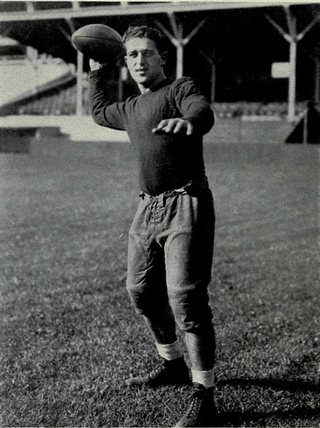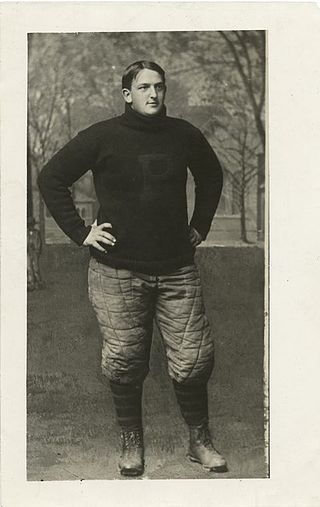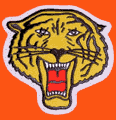Silver Stadium was a baseball stadium located at 500 Norton Street in Rochester, New York. It was the home stadium for the Rochester Red Wings of the International League from 1929 to 1996, and for the New York Black Yankees of the Negro National League for their final season in 1948. The ballpark also briefly hosted professional football as it was the home field for the Rochester Braves in 1936 and the Rochester Tigers in 1936 and 1937.
The first American Football League (AFL), sometimes called AFL I, AFLG, or the Grange League, was a professional American football league that operated in 1926. It was the first major competitor to the National Football League (NFL). Founded by Charles "C.C." Pyle, (1882–1939), and General Charles X. Zimmerman, (1865–1926), as vice president and starring Hall of Fame halfback Harold Edward "Red" Grange, (1903–1991), the short-lived league with nine teams competed against the more established – then six-year-old – NFL, both for players and for fans. While Pyle's and Grange's New York Yankees team and the already established Philadelphia Quakers became reliable draws, the lack of star power and the uncertain financial conditions of the other seven teams led to the league's dissolution after one season.

Harry Lawrence Newman was an All-Pro American football quarterback. He played for the University of Michigan Wolverines (1930–32), for whom in 1932 he was a unanimous first-team All-American, and the recipient of the Douglas Fairbanks Trophy as Outstanding College Player of the Year, and the Helms Athletic Foundation Player of the Year Award, he was later inducted into the College Football Hall of Fame. He then played professionally for the New York Giants (1933–35), and the Brooklyn/Rochester Tigers (1936–37).

William Hanford "Big Bill" Edwards was an American football player who played guard for the Princeton Tigers football team of Princeton University from 1896 to 1899.
The American Football League, also known retrospectively as the AFL III to distinguish it from earlier organizations of that name, was a professional American football league that operated from 1940–1941. It was created when three teams, the original Cincinnati Bengals, the Columbus Bullies, and the Milwaukee Chiefs, were lured away from the minor-league American Professional Football Association and joined three new franchises in Boston, Buffalo, and New York City in a new league. It competed against the National Football League (NFL), the oldest existing professional football league, established 1920 and reorganized 1922.
The American Football League (AFL) was a professional American football league that operated in 1936 and 1937. The AFL operated in direct competition with the more established National Football League (NFL) throughout its existence. While the American media generally ignored its operation, this second AFL was the first "home" of the Cleveland Rams, which joined the National Football League after one year in the AFL.
The Midwest Football League (MFL) was a professional american football minor league that existed from 1935 to 1940. Originally comprising teams from Ohio, Kentucky, Indiana, and Illinois, the league eventually expanded its reach to include teams from Missouri, Tennessee, Wisconsin, and California to become a national league with major league aspirations by 1939. In 1938, the league became the American Professional Football League after the collapse of the second major league of the same name, but changed its name once again the following year to American Professional Football Association (APFA). Some sources refer to it as the American Professional Football League.
The 1936 AFL season is the first season of the second American Football League, the formation of which was announced by Harry March, former personnel director of the NFL's New York Giants, on December 15, 1935. Fifteen cities bid for charter franchises; on April 11, 1936, franchises were awarded to eight cities: Boston, Cleveland, Jersey City, New York, Philadelphia, Pittsburgh, Providence, and Syracuse. By mid-summer, Jersey City, Philadelphia, and Providence withdrew; soon afterwards, Rochester was given a franchise, only to have it relocated to Brooklyn, despite the lack of availability of a home stadium at the time.
The 1937 AFL season is the second and final season of the second American Football League. After the folding of the Syracuse/Rochester Braves in the 1936 season and the departure of the Cleveland Rams for the National Football League, the league added the Cincinnati Bengals and the Los Angeles Bulldogs, the latter being the first professional football team to play its home games on the American West Coast.
The New York Yankees of the third American Football League was the third professional American football team competing under that name. It is unrelated to the Yankees of the first AFL, the Yankees of the second AFL, and the (later) Yankees of the All-America Football Conference. The Yankees played their home games in Yankee Stadium and Downing Stadium in New York, New York.
The 1941 AFL season was the second and final season of the third American Football League. After deeming the 1940 season to be a success, the league made overtures of expansion, even going to the point of having a press conference to announce the addition of new teams (July), but when the press conference was held, the Boston Bears had withdrawn from the league and the new Detroit franchise deferred entry for the 1942 season.
The 1940 AFL season was the first season of the third American Football League. The league was formed when the New York Yankees, Boston Bears, and Buffalo Indians were joined by the Cincinnati Bengals, Columbus Bullies, and Milwaukee Chiefs of the minor American Professional Football Association. After the announcement of the formation of the AFL, applications for membership by former APFA members St. Louis Gunners and Kenosha Cardinals were rejected by the upstart league, which started with six members.
The Chicago Bulls were a professional American football team that competed in the first American Football League in 1926. Owned by Joey Sternaman, the Bulls also had AFL founders C. C. Pyle and Red Grange as shareholders. Joey Sternaman was also the coach and blocking back for the Bulls throughout their brief existence.
The Buffalo Indians were a professional American football team that competed in the third American Football League in 1940 and in 1941. The team played its home games in Civic Stadium in Buffalo, New York. Owned by the Buffalo American Legion, the Indians were managed by Earl "Red" Seick, who was also player-coach for the team for the first five games in 1940. While most of the AFL membership focused on raiding the rosters of the local members of the National Football League teams, the Indians concentrated on signing local talent, castoffs from the NFL, and men who played in the defunct second American Football League.
The Milwaukee Chiefs were a professional American football team based in Wisconsin that competed in the third American Football League in 1940 and in 1941.
The Boston Bears were a professional American football team that competed in the third American Football League in 1940. Owned by Sheldon H. Fairbanks, the team played its home games in the Fenway Park in Boston, Massachusetts. Coach Eddie Casey’s team was a competitive one, finishing the 1940 season with a 5-4-1 record, good for third place in the AFL, behind league champions Columbus Bullies and second-place Milwaukee Chiefs.
The Syracuse Braves were a professional American football team that competed in the second American Football League in 1936 and 1937. Coached by Don Irwin and Red Badgro, the Braves played in Municipal Stadium, which had a capacity of only about 10,000 people. The team was not a strong draw as it lost its first five games, prompting a search for a new home, including Providence, Rhode Island, before settling upon a move to Rochester.
The Louisville Tanks were a minor league professional American football team that existed from 1935 to 1940. The team formed in the wake of the dissolution of the Louisville Bourbons of the short-lived American Football League of 1934. Organized and owned by American Standard, Inc., the team was coached by AS plant manager H.M. "Harry" Reed; its name and colors come from one of the products sold by American Standard. The Tanks played their home games at Parkway Field in Louisville, Kentucky, USA.
The New York Yankees of the second American Football League was the second professional American football team competing under that name. It is unrelated to the Yankees of the first AFL, the Yankees of the third AFL, the Yankees of the American Association and the (later) Yankees of the All-America Football Conference. The Yankees played their home games in Yankee Stadium and Triborough Stadium in New York, New York. Jack McBride was the team’s head coach throughout its existence; Yankees' president James Bush served as president of the second American Football League in 1936.
Lorenzo Thomas Ribble, Jr. was a professional football player in the National Football League for the Portsmouth Spartans, Chicago Cardinals and Pittsburgh Pirates. He also played in the second American Football League for the Pittsburgh Americans. He also played for the independent St. Louis Gunners in 1932 and the Memphis Tigers in 1933. The Gunners did not join the NFL until 1934.






